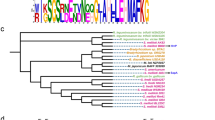Abstract
The importance and future potential of biological nitrogen-fixation is widely recognized. A further, yet unexplored and less known value of nitrogen-fixing root nodules is the presence of hundreds of plant peptides with antimicrobial activities and novel modes of action. These nodule-specific plant peptides are only produced in the Rhizobium-infected symbiotic cells where they abolish the endosymbiont’s cell division ability, transforming them to non-cultivable polyploid nitrogen-fixing cells. The symbiotic cationic peptides are able to kill a wide range of microbes, including important human pathogens. The peptides are highly stable and their interactions with multiple bacterial targets reduce the probability to develop resistance. Worldwide spreading of antibiotic resistant microbes became a major cause of mortality. Therefore there is an urgent need for novel antibiotics. The characteristics and multifaceted action of symbiotic peptides make them excellent antibiotic candidates.
Access this chapter
Tax calculation will be finalised at checkout
Purchases are for personal use only
Similar content being viewed by others
References
Alunni B, Kevei Z, Redondo-Nieto M et al (2007) Genomic organization and evolutionary insights on GRP and NCR genes, two large nodule-specific gene families in Medicago truncatula. Mol Plant Microbe Interact 20:1138–1148
Bassetti M, Merelli M, Temperoni C et al (2013) New antibiotics for bad bugs: where are we? Ann Clin Microbiol Antimicrob. 12:22. doi:10.1186/1476-0711-12-22
Becker-Ritt AB, Carlini CR (2012) Fungitoxic and insecticidal plant polypeptides. Biopolymers 98:367–384
Byrgazov K, Vesper O, Moll I (2013) Ribosome heterogeneity: another level of complexity in bacterial translation regulation. Curr Opin Microbiol 16:133–139
Farkas A, Maróti G, Durgő H et al (2014) Medicago truncatula symbiotic peptide NCR247 contributes to bacteroid differentiation through multiple mechanisms. Proc Natl Acad Sci U S A 111:5183–5188. doi:10.1073/pnas.1404169111
Guilhelmelli F, Vilela N, Albuquerque P et al (2013) Antibiotic development challenges: the various mechanisms of action of antimicrobial peptides and of bacterial resistance. Front Microbiol 4:353
Kerner MJ, Naylor DJ, Ishihama Y et al (2005) Proteome-wide analysis of chaperonin-dependent protein folding in Escherichia coli. Cell 122:209–220
Kevei Z, Vinardell JM, Kiss GB et al (2002) Glycine-rich proteins encoded by a nodule-specific gene family are implicated in different stages of symbiotic nodule development in Medicago spp. Mol Plant Microbe Interact 15:922–931
Kondorosi E, Mergaert P, Kereszt A (2013) A paradigm for endosymbiotic life: cell differentiation of Rhizobium bacteria by host plant factors. Annu Rev Microbiol 67:611–628
Mergaert P, Nikovics K, Kelemen Z et al (2003) A novel family in Medicago truncatula consisting of more than 300 nodule-specific genes coding for small, secreted polypeptides with conserved cysteine motifs. Plant Physiol 132:161–173
Mergaert P, Uchiumi T, Alunni B et al (2006) Eukaryotic control on bacterial cell cycle and differentiation in the Rhizobium-legume symbiosis. Proc Natl Acad Sci U S A 103:5230–5235
Nallu S, Silverstein KAT, Zhou P et al (2014) Patterns of divergence of a large family of nodule cysteine-rich peptides in accessions of Medicago truncatula. Plant J 78:697–705
Oono R, Schmitt I, Sprent JI et al (2010) Multiple evolutionary origins of legume traits leading to extreme rhizobial differentiation. New Phytol 187:508–520
Penterman J, Abo RP, De Nisco NJ et al (2014). Host plant peptides elicit a transcriptional response to control the Sinorhizobium meliloti cell cycle during symbiosis. Proc Natl Acad Sci U S A 111:3561–3566. doi:10.1073/pnas.1400450111
Silverstein KA, Graham MA, Paape TD et al (2005) Genome organization of more than 300 defensin-like genes in Arabidopsis. Plant Physiol 138:600–610
Tiricz H, Szücs A, Farkas A et al (2013) Antimicrobial nodule-specific cysteine-rich peptides induce membrane depolarization associated changes in Sinorhizobium meliloti. Appl Environ Microbiol. 79:6737–6746. doi:10.1128/AEM.01791-13
Van de Velde W, Zehirov G, Szatmari A et al (2010) Plant peptides govern terminal differentiation of bacteria in symbiosis. Science 327:1122–1126
Wilson DN (2014) Ribosome-targeting antibiotics and mechanisms of bacterial resistance. Nat Rev Microbiol 12:35–48. doi:10.1038/nrmicro3155
Acknowledgements
I am grateful to Pal Venetianer for critical reading of the manuscript. Our work is supported by the “SYM-BIOTICS” Advanced Grant of the European Research Council to EK (grant number 269067).
Author information
Authors and Affiliations
Corresponding author
Editor information
Editors and Affiliations
Rights and permissions
Copyright information
© 2015 Springer International Publishing Switzerland
About this chapter
Cite this chapter
Kondorosi, E. (2015). From Nodulation to Antibiotics. In: Lugtenberg, B. (eds) Principles of Plant-Microbe Interactions. Springer, Cham. https://doi.org/10.1007/978-3-319-08575-3_45
Download citation
DOI: https://doi.org/10.1007/978-3-319-08575-3_45
Published:
Publisher Name: Springer, Cham
Print ISBN: 978-3-319-08574-6
Online ISBN: 978-3-319-08575-3
eBook Packages: Biomedical and Life SciencesBiomedical and Life Sciences (R0)




